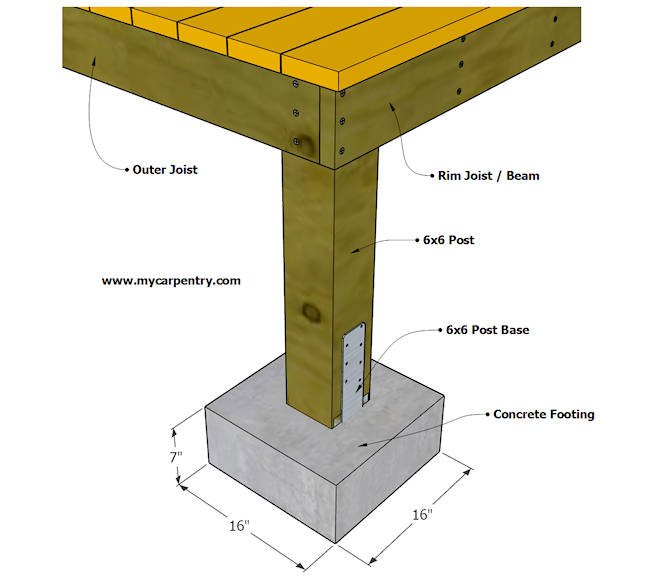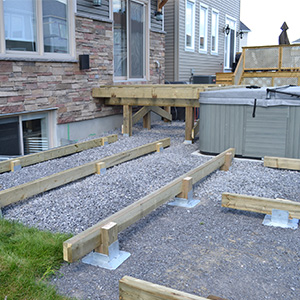A Strong Structure for Your Oasis: Exploring the Relevance of Deck Footings in Outdoor Structures
Wiki Article
Expert Tips for Setting Up Deck Footings to Support Your Outdoor Room
When it comes to building a deck, one of the most important components to take into consideration is the installation of appropriate footings. These grounds are the foundation upon which your outside area will certainly rest, giving stability and support for years to come. What exactly does it take to install deck grounds correctly?Relevance of Proper Deck Footings
Correct deck footings are crucial for guaranteeing the stability and durability of your exterior space. Without solid and correctly installed grounds, your deck may come to be unstable, leading to safety and security hazards and costly fixings.
Along with stability, correct deck footings likewise contribute to the longevity of your outside area (Deck Footings). Footings that are created and constructed to withstand the elements and dirt problems in your area will certainly help stop the deck from working out or shifting in time. By making sure the footings are appropriately sized and set up, you can decrease the risk of damages to the deck structure, extending its life-span and decreasing the demand for expensive repair work or replacements

Choosing the Right Sort Of Grounds
When picking the suitable kind of footings for your deck, it is very important to consider variables such as soil conditions, local building codes, and the overall design of your outside area. The kind of footing you pick will certainly play an essential role in guaranteeing the stability and long life of your deck.One usual type of ground is the concrete ground. Concrete grounds are ideal for many dirt conditions and supply exceptional support for decks.
In many cases, you might require to utilize customized grounds, such as heap footings or deep structures, if you are developing a multi-level or huge deck. These footings are created to disperse the weight of the deck over a larger area, making certain security and avoiding sinking or settling.
Prior to picking a kind of ground, it is important to get in touch with local building ordinance and guidelines to guarantee compliance. Additionally, consider the layout and meant usage of your exterior area. Aspects such as the size, shape, and load-bearing needs of your deck will certainly affect the kind of footing that is most ideal.
Preparing the Ground for Footing Installation
To appropriately prepare the ground for footing installation, it is vital to examine the dirt conditions and take essential steps to make sure security and resilience of the deck. The initial step is to dig deep into the area where the grounds will be set up.Once the location has been dug deep into, the next step is to compact the soil. This can be done utilizing a plate compactor or by using a hand tamper. Condensing the dirt aids to remove any kind of spaces or air pockets, which can cause working out and instability over time.
After condensing the soil, it is essential to lay a layer of crushed rock or smashed stone at the base of the excavation. This will certainly supply water drainage and help to avoid water from merging around the footings, which can lead to disintegration and instability.
Step-by-Step Guide to Installing Deck Footings
After correctly preparing the ground for footing setup, the next step is to begin the process of mounting deck grounds. This detailed guide will supply you with a clear understanding of how to install deck grounds for your exterior space.Figure out the area: Start by noting the settings of the deck grounds utilizing stakes and string. Make sure that the areas straighten with the layout and design of your deck.
Dig the holes: Utilize an article hole digger or an auger to dig the holes for the footings. The deepness and size of the holes ought to be in accordance with local building regulations and the specific requirements of your deck design.
Level the holes: Make use of a degree to make certain that the openings are dug to the correct deepness and are degree with each various other. (Deck Footings)
Add gravel: Place a layer of gravel at the end of each opening to enhance water drainage and avoid the wood from decomposing.
Put the footings: Place the footings into the holes, making certain they are level and plumb. Use a level and a determining tape to make sure accuracy.
Safeguard the footings: Put concrete into the holes around the grounds, filling them to the top. Use a blog post degree to guarantee the grounds stay level as the concrete Clicking Here collections.
Enable time for curing: Allow the concrete cure according to the supplier's directions before waging the deck building and construction.
Typical Mistakes to Stay Clear Of During Footing Installation
One important element to take into consideration during the installment of deck footings is staying clear of typical blunders that can jeopardize the security and longevity of your exterior space. While deck grounds may appear like a easy and straightforward component of the building process, neglecting certain factors can bring about pricey repairs and potential safety risks down the line.
Additionally, ignoring to install proper water drainage measures can create water to gather around the footings, resulting in rot, degeneration, and the eventual weakening of the deck's foundation. Making use of the wrong kind of footing material or stopping working to sufficiently secure the footings can jeopardize their architectural honesty.
To prevent these errors, it is important to speak with an expert or adhere to sector guidelines to guarantee appropriate ground installment. By doing so, you can ensure the stability and durability of your outside room, providing a risk-free and satisfying atmosphere for several years to come.
Verdict
Finally, setting up proper deck footings is important for the security and durability of your outside room. By picking the right kind of grounds and properly preparing the ground, you can Bonuses make sure a solid foundation for your deck. Following a step-by-step guide and avoiding common errors throughout footing installment will certainly additionally improve the longevity and safety and security of your deck.Correct deck grounds are necessary for making certain the security and durability of your outside space. The footings offer as a link between the deck and the ground, allowing the weight of the deck and its residents to be dispersed evenly right into the dirt.One typical type of footing is the concrete ground. Put the grounds: Position the grounds into the openings, click here for info making certain they are degree and plumb. Secure the footings: Put concrete right into the openings around the footings, loading them to the top.
Report this wiki page